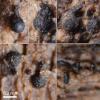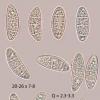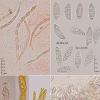
20-12-2025 23:08
Patrice TANCHAUDBonsoir, récolte sur sol sablonneux dans l'arri�

21-12-2025 09:32
Hello.A tiny ascomycete found embedded in wood in

20-12-2025 15:47
Mirek GrycHi.These grew on pine wood that was heavily covere

18-12-2025 21:17
Pol DebaenstThe identification took me to Byssonectria deformi

15-12-2025 07:09
 Danny Newman
Danny Newman
indet. Rutstroemiaceae sp. on unk. fallen leavesMc

19-12-2025 10:10
Patrice TANCHAUDBonjour, récolte réalisée en milieu dunaire, a

18-12-2025 17:23
 Bruno Coué
Bruno Coué
Bonjour,je serais heureux d'avoir votre avis sur c
Hi forum
These scattered, more or less inmersed, black, ostiolate, glabrous, lageniform perithecia, 0.3-0.5 mm long, with elongated cylindrical necks 100-200 microns long, were growing on indeterminate semirotten wood together with pseudothecia of Capronia cf. pilosella.
The asci are shortly stipitate, with a conspicuous refractive, IKI negative, apical apparatus, 170-194 x 10-12 microns, with 8 obliquely 1-seriate, hyaline, 4-celled ascospores. Paraphyses often collapsing.
I think this fungus should be near the genus Ceratosphaeria but any species seems to fit well with my collection.
Have yo some idea for me?
Thanks again
Your collection seems to be referrable to Ceratosphaeria, characterised by the elongated beak, spores having several cross walls, often more than three..By definition the genus Zignoella has at most a papillate ostiole, and spore cross walls at most three.
Suggested taxa for your collection are Ceratosphaeria crinigena or possibly C. rhenana
Kind regards,
Peter

since the great work done by Martina Réblova it became unfortunately challenging to assign one of these beaked fungi to a genus without the asexual morph and molecular data.
There is a good overview of these fungi with a key to genera in Réblova 2013, Mycologia 105: 462-475. Your fungus might have affinities with Ceratolenta caudata but has significantly larger ascospores.
Enrique, you should make an effort to find fungi that exist!
Saludos,
Jacques

Zotto
You are right, Zotto! Your memory is surprising...http://www.ascofrance.fr/search_forum/38103 But for this collection on Rubus, also out and far of the water, i could not to observe the inmersed ascomata. But I think Annulusmagnus has greater ascospores and a more conspicuous, very congophilous, apical apparatus.
Who knows!



